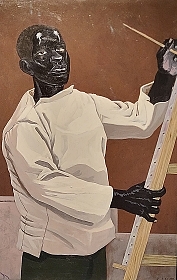Entangled messaging at an exhibition at London’s Royal Academy
I LEAVE SOME EXHIBITIONS feeling both inspired and exhilarated. Some other displays of art neither thrill nor depress me. However, the current show at the Royal Academy of Art (‘RA’) in London’s Piccadilly – “Entangled Pasts 1768 – now” – left me feeling both disappointed and a little irritated. Before proceeding further, I should explain that 1768 was the year in which the RA was founded. The exhibition is, to quote its associated handout, to explore:
“… connections between art associated with the Royal Academy and Britain’s colonial histories.”

It does this by mixing artworks by academicians with those by other artists in a series of mostly poorly lit, gloomy galleries. Each of the rooms is supposed to contain works that are connected with a particular theme, although I found that the linkage between the artworks and the theme within each gallery was weak to say the least.
The sad thing is that many of the exhibits on display are interesting works of art, but seeing them altogether reminded me of visiting a poorly organised jumble sale. Although the works in each room were supposed to be thematically linked, that was hard to realise by looking at them as a group. The overarching concept of the exhibition was to, yet again, remind us of Britain’s unsavoury history of relations with ‘people of colour’. Consequently, many exhibits were ones that had been exhibited before in shows with similar messaging. One gallery managed to combine the unpleasant history of Britain’s involvement with the slave trade with another topical subject – climate change. This is probably because there are many who link colonialisation with industrialisation and its effects on climate.
Although I am presenting you with a negative view of the exhibition, I should in all fairness point out a couple of things I loved. One was an installation consisting of models of ships suspended from the ceiling by fine threads. This visually exciting work was created by Hew Locke, and was in one of the few rooms that was brightly lit. The other exhibit, which occupied two galleries was a collection of painted wooden cut-outs depicting people at a carnival. This work, which was accompanied by a soundtrack with voice and music, was created by Lubaina Hamid – like Locke a Royal Academician – in 2004. I was also interested to see the original painting of Dido Elizabeth Belle and her cousin Lady Elizabeth Murray by David Martin (1737-1797), who was a Royal Academician. These two ladies were associated with Kenwood House in north London, where a photograph of the painting is on display. It was nice to see the original. There were other artworks I liked in the exhibition, but felt that their impact was spoiled by being displayed alongside other works without much evidence of thoughtful curating.
I felt that “Entangled Pasts” was yet another ‘blockbuster’ show designed to earn income, which is greatly needed in the present difficult economic climate. This exhibition exploits the race card to attract visitors, which it appears to be doing. Just in case I have not discouraged you from seeing the show, you should know that it ends on the 28th of April 2024.



